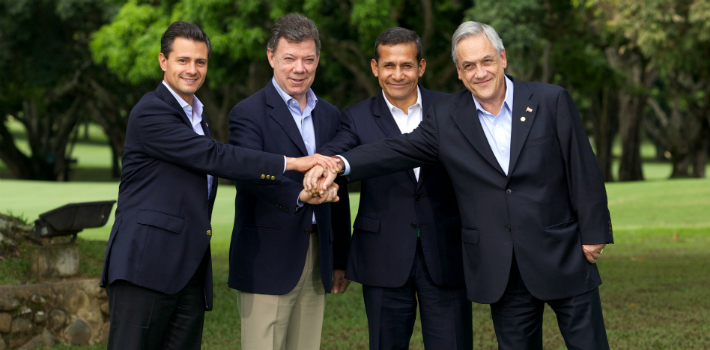EspañolOn April 28, 2011, the presidents of Mexico, Colombia, Peru, and Chile met in Lima, Peru, to highlight the progress that the four countries had achieved in terms of development, inclusive economic growth, productive employment, poverty reduction, and the strengthening of democracy. Given these common achievements, they decided to establish a mechanism for political dialogue and economic integration.
The main objective was to form an area of integration for generating growth, development, and competitiveness for the economies of the member countries through the free flow of goods, services, capital, and people. This initiative, called the Pacific Alliance, also seeks to strengthen ties with other regions, particularly Asia and the Pacific, which is emerging as the global economy’s cornerstone for the 21st century.
On February 10 this year, the presidents of the four countries signed a trade agreement in Cartagena, Colombia. They created an area for the free circulation of 92 percent of the products of member countries, which will also create cross-border production chains for boosting the competitiveness of production processes. Trade liberalization is a reality. This free market reaches nearly 220 million consumers, represents about one third of GDP in Latin America, concentrates 50 percent of its total trade volume, and attracts 41 percent of Foreign Direct Investment (FDI) flowing into the region.
According to the periodical Economía y Negocios, the Pacific Alliance exceeds Mercosur‘s FDI volume (a competing regional bloc), attracting US$84.3 billion in 2013, versus $83 billion for Mercosur. Taken as a whole, the alliance is the world’s eighth largest economy and seventh largest exporter. Also, the stock exchanges of Colombia, Peru, and Chile are linked through what is known as the Integrated Latin American Market (MILA). Mexico’s stock exchange is already in the process of joining MILA, which will allow the alliance to rival Brazil as Latin America’s largest stock market.

However, the alliance has not been free from threats and political overtones. When Ollanta Humala won the presidency of Peru in 2011, Brazil’s support for his campaign seemed to imply a Peruvian reproach. A Lima-Brasilia scheme became a possible substitute for the Mexico-Bogota-Lima-Santiago axis. But that didn’t happen; on the contrary, Humala’s active participation in the alliance served to smooth over ideological differences: the president said that the alliance seeks to improve the economy of its members and is not against anyone.
Similarly, Michelle Bachelet said during the campaign that led her to Chile’s presidency that she would approach her participation in the alliance with an inclusive perspective. As analyst Andrés Oppenheimmer notes, there was speculation that Chile might cease to be one of the pillars of the alliance. However, such fears vanished during Bachelet’s bilateral meetings with the presidents of Mexico, Peru, and Colombia during the recent CELAC summit.
Beyond political overtones, the Pacific Alliance, just 18 months after its inception, has established itself as a true free trade area. That is in contrast to more statist schemes like Unasur, Mercosur, and ALBA. Despite years of pompous fraternal declarations, these blocs don’t amount to much more than protectionist schemes against foreign competition.
It is true that there are still many challenges ahead, but the alliance continues to advance, slowly but steadily. One of those challenges, related to the implementation of the trade agreement, is improving the logistical competitiveness of the four member countries, as indicated by Carlos Chiappori, chairman of Comex Peru. This was one of the ten points that the Alliance Business Council proposed to the presidents. The Inter-American Development Bank (IDB) has offered to conduct a study to dissect these logistics processes, to enable every citizen of the area to know how easy or difficult it is to conduct import/export operations in any of the member countries. Other concerns include the harmonization of technical standards, and the interoperability of a mechanism to centralize all bureaucratic requirements for foreign trade (Foreign Trade Single Windows).
What is definitely clear, is that the strength of these countries lies in being united under the same goals and the same vision of development: approaching trade as an opportunity, not a threat. The Pacific Alliance is a dynamic initiative not only with great potential, but also with proven results; it reflects an open and inclusive integration process for a set of countries that consider free trade a key development driver. One hopes, now that Costa Rica has begun the process of joining the alliance, other countries aligned with the interests of the group will also feel compelled to join in the future.
Translated by Alan Furth.
 Versión Español
Versión Español












